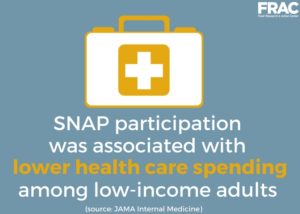A new white paper from FRAC reviews the latest research from academic, government, and other sources on the harmful impacts of poverty, food insecurity, and poor nutrition on the health and well-being of children, adults, and older adults. Two other accompanying white papers describe the critical role of the Supplemental Nutrition Assistance Program (SNAP) and the federal Child Nutrition Programs in alleviating poverty, reducing food insecurity, and improving nutrition, health, and well-being.
Check out the main takeaways from top-level research.
Hunger is a Health Issue

Food insecurity — even marginal food security (a less severe level of hardship often not included as food insecurity) — is associated with some of the most common and costly health problems among adults and older adults, including fair or poor health status, diabetes, obesity (primarily among women), hypertension, and depression.
For children, research shows a link between food insecurity and lower health status, low birth weight, anemia, more frequent colds and stomachaches, asthma, developmental risk, mental health problems, and poor educational performance — all of which have health and economic consequences in the short and long terms.
Because of limited financial resources, households that are food insecure also may use coping strategies to stretch budgets that are harmful for health, such as engaging in cost-related medication underuse, postponing or forgoing preventive or needed medical care, or forgoing the foods needed for special medical diets (e.g., diabetic diets). Food insecurity and coping strategies such as these can exacerbate existing disease and compromise health.
Not surprisingly, research shows that household food insecurity is a strong predictor of higher health care utilization and increased health care costs.
The Federal Nutrition Programs are Key Health Supports and Interventions
Clearly, food insecurity has detrimental impacts on the health and well-being of children, adults, and seniors. One critical strategy to address these impacts is connecting more people to the federal nutrition programs. Below is just some research demonstrating the health-related benefits of these programs:
- According to one estimate, annual healthcare expenditures average $1,409 lower in the case of SNAP participants versus non-participants, and even larger differences occur among SNAP participants with hypertension or coronary heart disease.
- Access to SNAP in utero and in early childhood reduces the incidence of metabolic syndrome (obesity, hypertension, diabetes, heart disease, heart attack), reduces the risk of stunting, and, for women, increases reports of being in good health in adulthood.
- School breakfast, including breakfast offered at no cost to all students, has been linked with fewer visits to the school nurse, particularly in the morning, and positive impacts on mental health, including reductions in behavioral problems, anxiety, and depression.
- Free or reduced-price school lunches reduce rates of poor health by at least 29 percent, based on estimates using national data.
- Enrollment in the Special Supplemental Nutrition Program for Women, Infants, and Children (WIC) and greater use of the WIC food package during pregnancy are associated with improved birth outcomes, including lower risk of preterm birth, low birth weight, and perinatal death.
These are a few of the key research findings digested in these three new white papers. The federal nutrition programs are effective and available in communities across the United States. Increasing access to, and strengthening, SNAP and the Child Nutrition Programs would further their role in improving the health of the nation.


